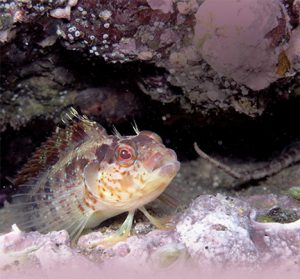
When we boarded the Sundiver Express we were headed for Catalina Island, but when we reached our dive site, the skipper, Kyaa, said we’d just reached Africa. I’m not exactly certain how Africa Cove got its name, but I’m guessing it’s because exploring this site is like being on an underwater safari.
Almost immediately I found a pair of moray eels and about a half-dozen lobsters. Africa Cove is part of a Marine Conservation Area, which accounts for some of its bounty. As with most Catalina Island reefs, good portions of the rocks were sprinkled with bright blue-banded gobies. You can’t miss these one- to two-inch long reef fish with their bright red and iridescent blue bands. If you are lucky enough to get really close to these guys you’ll notice they have tiny little fangs they use to pick bits of food out of the water column. They can actually look quite ferocious. Fragile stars provide another pop of color. Touch them with your light and a rich brick red appears. These stars appear to have dodged the bullet of the mysterious disease that decimated star populations of other species over the last couple of years. The affected species are making a comeback in some areas, but it isn’t noticeable at Africa Cove. Other interesting invertebrates here include big black sea hares with their spaghetti-like yellow egg clumps, octopus hiding in holes, and big wavy turban snails.
Spearfishing is allowed here. For the most part this is not productive, but if you insist, try searching the sandy areas for halibut. This has traditionally been a great spot for hunting “flatties” although you won’t likely find the “barn door” size, to use halibut hunter lingo.
The most exciting part of this dive for me was the terrain. A ridge reef extends off the point approximately 150 yards. The sand bottom drops away on either side of the rocks but the reef narrows to a ridge as it extends out from shore. Sadly there is currently no kelp here, but on a positive note, it allows you to fully appreciate the scope of the reef. Reaching out from the island it becomes even more dramatic. There are many deep crevices and holes to explore. The more spectacular the reef becomes, the greater the size of the schools of swirling blacksmith fish. Bright orange garibaldi buzz around above and nest below as evidenced by the patches of yellow eggs that the males of the species guard voraciously. Look for large calico bass as they hole up in mini caves. Reaching seaward, pinnacles dominate the scenery. At the very end of the ridge is the tallest peak that tops out at 25 feet down, dropping off vertically to a sandy bottom at 65 feet. The rocky point usually has a steady but mild current, which keeps the water clear and attracts fish life. This is my favorite place on this reef. Dropping down to the bottom I noticed the drop in temperature. This is a good thing, as chilly nutrient-rich water feeds the life on the reef. As I felt a slight shiver I heard the beeping of my computer, signaling it was time to end the dive. My underwater safari was a fun adventure, making me wish to return to Africa Cove again soon. Only next time, maybe I’ll switch to my dry suit.
At-A-Glance
Skill Level: Novice to advanced depending on particular section of the dive area.
Location: Along the front side (mainland side) of Catalina Island between the Isthmus west toward Arrow Point. GPS N33°27.383’, W118°30.722’.
Access: Boat only.
Entry and Exit: Usually easy in calm waters.
Depth Range: 20 to 65 feet.
Conditions: Usually protected with light but steady current and upwelling on end of reef.
Visibility: 30 to 50 feet.
Photography: Very good for wide angle with a highly varied reef structure. Fair macro.
Hunting: Invertebrate preserve. No lobster or other invertebrates may be taken.
Cautions: Boat traffic.






